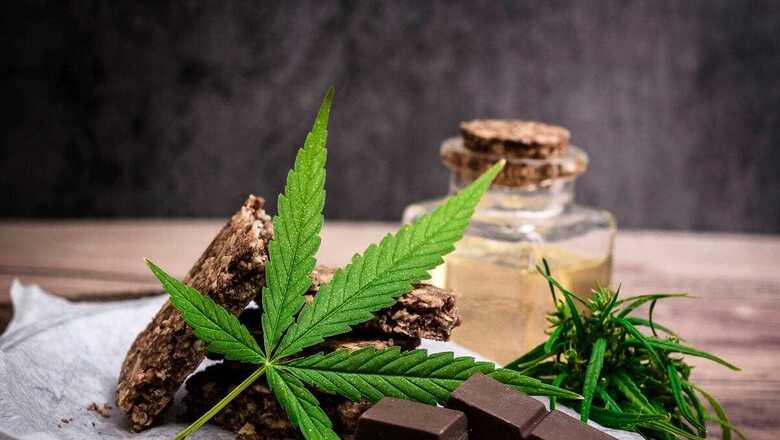
views
Death by Chocolate is a very popular cake among youngsters, everywhere. Perhaps the unique title also adds to the curiosity to taste this delicacy. However, vying for popularity among youngsters is also a variety of expensive drugs like ecstasy, heroin, cannabis, methamphetamine, and even cocaine.
Chocolate stimulates unique brain activity, activating similar brain regions and neurobiological substrates with potentially similar psychoactive effects as drugs or substances of abuse. Eating chocolate makes a person happy, as it promotes the release of dopamine, a feel-good neurotransmitter, into particular regions of the brain: the frontal lobe, hippocampus and hypothalamus. It also increases cerebral blood flow, promotes synaptogenesis (the formation of synapses between the neurons) and accumulates in the hippocampus, the part of the brain associated with memory.
Chocolate also contains small amounts of a compound called phenylethylamine, which acts like an amphetamine, stimulating brain cells to release dopamine, and endorphins, known as the ‘feel-good’ chemical of the brain. Endorphins and dopamine are both chemicals in the body that create the feeling of happiness, but they function in different ways. Endorphins relieve pain naturally. When they attach to the brain’s reward centres (opiate receptors), dopamine gets released. There are four chemicals that have been identified as playing a key role in promoting feelings of happiness, which are serotonin, dopamine, endorphins and oxytocin. Apart from these, there are nearly 380 compounds in chocolate that affect brain chemistry very profoundly.
Modern societies, across the globe, are rapidly becoming hedonistic in nature. Youngsters are obsessed with enjoying the pleasures of eating, drinking, listening to music, and having sex. As people become increasingly indolent and by nature, lotus-eaters, there is a heavy demand and reliance on strong pleasure-inducing substances. Chocolate is not sufficient for inducing long spells of pleasure and the much-craved ‘dreamy state’. A variety of substances are now available that can stimulate hedonic motivation to indulge in smoking, sniffing, injecting, and drinking, continuously. Hedonistic addiction to enjoy a prolonged, uninterrupted spell of enjoyment is what tempts many to undertake a drug journey. A hedonistic lifestyle has no beliefs other than the well-being of the self, it has no rules, regulations, codes or laws. There are no gods or demons to be afraid of. Many commentators are of the opinion that when Thomas Jefferson summarised human rights, it was hedonism he was referring to when he defined it as “life, liberty and the pursuit of happiness”. Hence people smoke, drink and inject drugs of different kinds as it gives them a good and happy feeling, lasting for several hours. There is no dependence on other human beings, beliefs, and rituals to become happy, just a puff, sniff, or a sip generates euphoric happiness from within. This is the simple hedonistic philosophy to indulge in drugs, it is just pleasure-oriented behaviour. Drug use, in this sense, is a voluntary behaviour, motivated by pleasure. It is normal human behaviour to seek repeated indulgence in a pleasurable experience, hence the repeated use of drugs. It is pointless to explain the Disease Model of Addiction to such pleasure seekers. This explains the failure of drug awareness campaigns across the world.
Just as for young children, chocolates give immense pleasure, in teens and later years, drugs give that same excitable pleasure, stronger and overwhelming, and for long spells of time. In the pursuit of strange pleasures, nothing matters, neither the cost of the drugs, broken relationships, legal penalties, arrests and detentions, nor loss of jobs.
Addiction begins with the hope that “something out there can instantly fill up the emptiness inside,” said Jean Kilbourne, American Public Speaker. Addiction is a series of mental and emotional associations between a drug of choice and the individual’s desire about what feelings to experience. Most people associate drugs with peace, calm, and relaxation. Ironically, sadness is one of the most triggering emotions for many addictions. By using a particular drug of choice, users hope to create feelings of happiness. Why is it that users associate drugs with joy?
Similar to chocolate, drugs and alcohol induce the brain to release the chemical dopamine. The surge in dopamine gives rise to feelings of wellness, ease, calm, happiness and joy. Many a time, it even gives a sense of rash bravado and heightened courage. This transformative experience given by various kinds of chemicals lures the user to repeated usage, till it starts showing debilitating signs on the physical and mental health. The chemical invasion of the brain and the fraudulent, temporary happiness that occurs soon becomes an enslaving addiction with hardly any escape route, for most drug addicts. About chocolates, there is a famous anonymous quote “If I must die, let it be death by chocolate.” People addicted to drugs share a similar view that death by drugs is an attractive proposition. Little do they know that “Drugs take you to hell, disguised as heaven” (Donald Lyn Frost).
The author is IRS (Rtd), Ph.D. (Narcotics), Former Director General, National Academy of Customs, Indirect Taxes & Narcotics (NACIN). Views expressed are personal.
Read all the Latest Opinions here




















Comments
0 comment